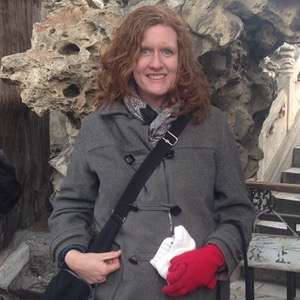
Amanda Regnier
Director
BA, Oglethorpe University, 1999
MA, University of Alabama, 2001
PhD, University of Alabama, 2006
Research Interests
I am an archaeologist who specializes in the southeastern United States. My dissertation research focused on the societies contacted by sixteenth-century Spanish military expeditions in central Alabama and the impacts of those events. I used styles of decoration on ceramics to understand how these societies functioned before contact. I also have used changes in ceramic styles to interpret the drastic effects of a brief, violent encounter with the AD 1540 Hernando de Soto expedition and the effects of more prolonged exposure to the AD 1560 Tristan de Luna expedition.
My current research in Oklahoma is focused on precontact Caddo sites in the Red and Arkansas drainage basins and on Removal Period military and plantation sites. With my colleagues Scott Hammerstedt at the survey and Patrick Livingood in Anthropology, I have directed field projects at the Clement site, an A.D. 1050 through 1450 mound center in the Red River drainage of southeast Oklahoma, and at the Spiro Mounds Archaeological Site, along the Arkansas River in eastern Oklahoma. For the Spiro project, we are joined by a research team from the Arkansas Archeological Survey. At Spiro, we have conducted a geophysical survey of open areas in the site, including full gradiometer survey and electrical resistance and ground-penetrating radar survey of selected areas. In 2013 and 2014, we conducted excavations of anomalies interpreted as temporary structures along Spiro’s Lower Terrace, near the Craig Mound. Craig Mound was famously looted in the 1930s, unearthing the largest cache of precontact Native American art north of the Rio Grande.
I am currently completing a book manuscript on 1930s WPA excavations in the Arkansas drainage, at mound sites outlying Spiro. Understanding these sites, which have long been underreported, is key to understanding the events surrounding the interment of massive amounts of finely-crafted artifacts in the Craig Mound. Our book focuses on the expressions of shared religion exhibited in mound construction, mortuary ritual, and domestic architecture at these mound sites.
In addition to work in the Arkansas drainage, I also conduct research on antebellum sites in eastern Oklahoma, examining life on early frontier forts and the little-known plantation economy of eastern Oklahoma. I have conducted excavations and analysis of materials from early U.S. military outposts at Fort Gibson and Fort Washita. I recently completed a project to analyze more than 30,000 artifacts excavated from the 1820s-1850s Officers’ Quarters at Fort Gibson in 2009 and am working on analyzing materials excavated from what is believed to be a wheelwright’s shop with a forge dating to the 1840s-1850s at Fort Washita. In addition, I have worked at plantation sites such as Rose Hill Plantation in Choctaw County and the Murrell Home in Cherokee County.
I also occasionally conduct archaeological research outside of Oklahoma. Most recently, I accompanied a research team directed by Dr. Marc Levine of the Sam Noble Museum of Natural History at OU to the monumental center of Monte Alban in Oaxaca, Mexico. Along with my colleague Scott Hammerstedt, we conducted geophysical survey, close-interval topographic mapping, and drone-based photogrammetry in the main plaza. The exciting results of this project, which was funded by a grant from the National Geographic Society, will be released to the media soon!
Research Interests: Ancestral Caddo sites in the Red River drainage, Spiro and related mound sites in the Arkansas drainage, 19th century Removal period archaeology of eastern Oklahoma, Initial Spanish contact period sites in central Alabama.
Publications
Hammerstedt, Scott W. and Amanda L. Regnier
2017 The Story of WPA Excavations at Eastern Oklahoma Mound Sites. Manuscript under contract, University of Alabama Press, Tuscaloosa.
Hammerstedt, Scott W., Jami J. Lockhart, Patrick C. Livingood, Tim Mulvihill, Amanda L. Regnier, George Sabo III, and John Samuelsen
2017 Multisensor Remote Sensing at Spiro: Discovering Intrasite Organization. In Archaeological Remote Sensing: Applications in North
America, edited by Duncan P. McKinnon and Bryan S. Haley. University of Alabama Press, Tuscaloosa.
Regnier, Amanda
2017 The Relationship between Becoming Caddo and Becoming Mississippian in Southeast Oklahoma. In Mississippian Beginnings, edited by
Gregory Wilson, University of Florida Press, Gainesville.
Regnier, Amanda
2014 Reconstructing Tascalusa’s Chiefdom: Pottery Styles and the Social Composition of Late Mississippian Towns in the Alabama River Valley.
University of Alabama Press, Tuscaloosa.
Regnier, Amanda, Scott Hammerstedt, and Nicholas Beale.
2014 The Grobin Davis Site: Archaeogeophysics and Settlement Patterns at Caddo Mound Centers in Southeast Oklahoma. Southeastern Archaeology 33(1):87-107.
Regnier, Amanda
2013 The McDonald Site: An Analysis of WPA Excavations at a Caddo Site in the Glover River Drainage, McCurtain County, Oklahoma. Caddo Archeology Journal, 27-66.
Regnier, Amanda, Patrick Livingood, and Scott Hammerstedt
2013 The End of the WPA in Oklahoma: The Clement and McDonald Site. In Shovel Ready: Archaeology and Roosevelt’s New Deal for America, edited by Bernard Means, University of Alabama Press.
Hammerstedt, Scott, Amanda Regnier, and Patrick Livingood
2010 Geophysical Investigations at the Clement Site, McCurtain County, Oklahoma. Southeastern Archaeology 29(2):279-291.

